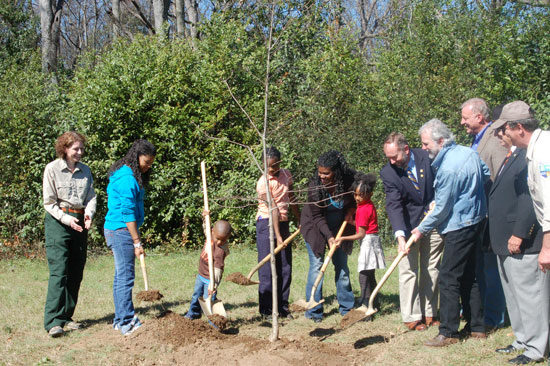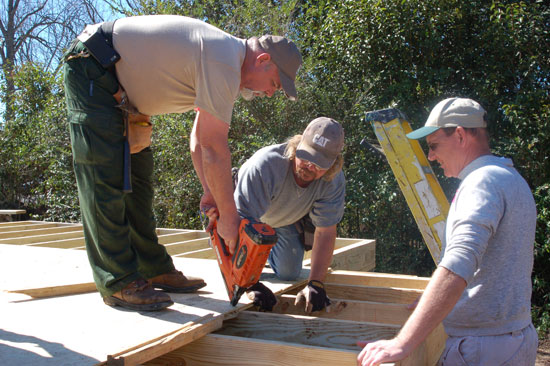Sustainable Building with SFI Certified Wood
Building Projects Using SFI Certified Products
With recognition and incentives comes market action. Examples of the use of SFI certified-wood in recent green building projects are found across the United States and in Canada across myriad building types. The latest is a Habitat for Humanity home in Macon, Georgia, now under construction. SFI has a unique network of 35 community-based SFI Implementation Committees (SICs) that respond to diverse local needs and engage directly in landowner education and training of logging professionals, as well as community projects.
  |
Georgia Forestry Community and SFI work with Habitat for Humanity to build the Jones family a new home. Photos courtesy of Georgia Forestry Community |
Led by the Georgia SFI Implementation Committee among others, the build will be used to help demonstrate sustainability from the harvesting of trees from a Georgia forest and manufacturing at area mills to building the home—and then replanting the forest for the next generation. “We are pleased to partner with the Georgia Forestry Commission and SFI on the building of the decent, safe, accessible and affordable home for the Jones Family,” said Harold Tessendorf, Executive Director for Macon Area Habitat. “Habitat builds home with families in need of simple, decent, and affordable housing. Knowing that we are also building sustainably—using locally sourced materials certified to the SFI Standard—makes this build even more special, especially when it is also taking place within the wider context of our ongoing work to revitalize the Lynmore Estates neighborhood in south Macon.
Blakely Hall, a municipal building in Issaquah, Washington, designed by the Seattle-based architecture firm Weber + Thompson, earned Green Globes certification for its use of SFI-certified timber trusses from the Port Blakely Tree Farm. The hall utilized local materials whenever possible, such as the trusses that are showcased in a series of exposed columns in the main hall. Blakely Hall was the first building in the United States to earn Green Globes certification.
Another Washington building project, the new Hands-On Children's Museum of Olympia, Washington, designed by The Miller/Hull Partnership of Seattle, was built using SFI-certified wood donated by several companies based in Washington state.
The new museum building, with its wood and metal cladding and ample windows, is the centerpiece of a newly built cluster of sustainable buildings on Olympia's East Bay, sited atop a former industrial location and brownfield. Achieving both LEED and Green Globes certifications, the facility employs waste methane power supplied by a cogeneration plant nearby, as well as reclaimed water for the museum's pools and fountains. Inside, low-emitting building materials improve the indoor environmental quality, or IEQ, with paints, adhesives, flooring materials and composite woods that have zero or low VOC levels.
The museum project achieved a Green Globes New Construction (NC) certification with credits earned for certified wood products. Under the Green Building Initiative's assessment and rating system, building projects earn points based on the “proportion of solid lumber, engineered wood, and other wood-based products [which] originate from sustainable sources that are a third-party certified sustainable forestry program,” including SFI. The New Construction module forms the basis of its Proposed American National Standard for the design and construction of commercial buildings.
The 28,000-square-foot Museum achieved a score of 783 out of 933 available points, or 84 percent, earning an award of Three Green Globes. (With 85 percent or more of the points, the museum would have earned Four Green Globes, the highest rating.) In the “resources” category, the score earned was 86 percent.
Berschauer Phillips Construction's Drew Phillips, describes the positive economic and environmental considerations behind the choice of wood. According to the project team, all of the 2x6 wall studs and the heavy timber beams, girders and columns are certified to meet SFI standards. “From my perspective it's important to specify certified wood,” Phillips says. “Wood that comes from sustainably managed forest is just a more environmental approach to building.”
SFI Program Participants supported the project with donations and in-kind contributions—from companies like Weyerhaeuser and groups like the Washington State SFI Implementation Committee to local fabricators and suppliers such as Custom Source Woodworking, Inc., Christopherson Wood Floors, Windfall Lumber and International Wood Products. “The Hands-On Children's Museum has demonstrated an exceptional commitment to sustainability through the policies and procedures that have been implemented as part of the construction of their new facility,” commented Eric T. Truelove, GGA, Assoc. AIA, principal of Madison, Wis.-based Green Building Resources, in the award of the Green Globes rating.
The benefits seen in these case studies of using the SFI standard for architectural and construction wood products certified to SFI is not lost on the broader building community. When green building tools recognize all forest certification standards they support more responsible forestry while giving the architectural community more options to source responsibly.
 |
SFI Inc. is an independent, nonprofit 501(c)3 organization that is solely responsible for maintaining, overseeing, and improving the internationally recognized Sustainable Forestry Initiative® (SFI®) program. SFI Inc. is governed by a three-chamber board of directors representing environmental, social, and economic sectors equally. Learn more at www.sfiprogram.org and sfiprogram.org/BuySFI |








